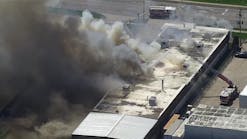CHICAGO, IL: SEPT. 1, 1914 – The quick and determined thinking of Oscar Pjork, the captain of the excursion boat City of Chicago, which was 12 miles from the harbor when a fire broke out, saved his crew and 300 passengers. With his radio out of service, the captain decided his best chance to prevent panic and keep matters under control was to head toward his pier at full speed, while letting the passengers remain asleep in their cabins. As the pier became visible, he had the passengers brought forward on the decks as he continued toward the pier. His plight was seen from shore and two fire tugs and several other vessels met him. He edged the bow into the government breakwater and took control of the situation. The captain ordered the men to wait onboard until all the women and children were safely off the boat. Amazingly, all hands made their way to safety as the fire tugs fought the blaze.
ETNA GROVE, IN: SEPT. 2, 1914 – Lightning struck, igniting a fire in a railway station that was quickly out of control. Despite a severe storm pouring down on the hamlet, the flames leaped from building to building, destroying nearly every structure. Five hundred people were left homeless.
PORTSMOUTH, NH: SEPT. 5, 1914 – The Appledore, a summer hotel on Appledore Island, was destroyed by a fire several days before it was set to close for the season. The flames also consumed several cottages. Damage was estimated at $150,000.
SEA BRIGHT, NJ: SEPT. 7, 1914 – The gasoline tank of a Benz racing car exploded, setting fire to a garage and trapping the auto’s chauffeur on the second floor. The only fire engine in town was already battling a house fire. With no alternative, he was forced to jump out a window and sustained a broken leg. This racing car had won the Vanderbilt Cup race in 1913.
HAINES FALLS, NY: SEPT. 9, 1914 – The guests of Twilight Inn were in an uproar during the afternoon as flames caused by crossed electrical wires set fire to the upper stories of the building. With no organized fire protection and the only available water stored in large tanks at each cottage or inn, the locals and guests formed a bucket brigade. After an hour, they had the fire under control and saved the building.
BROOKLYN, NY: SEPT. 12, 1914 – First-due companies arrived to find the four-story wooden foundry building of the Brooklyn Iron Foundry on Greenport Avenue fully involved. To further complicate matters, the exposure across the street from the blazing building was one of five huge tanks of the Standard Oil Co. Directly behind the fire building was a lumberyard. Deputy Chief Lally transmitted a fourth alarm on arrival. This brought Acting Chief of Department “Smoky Joe” Martin from Manhattan to direct the difficult fire.
GALILEE, NJ: SEPT. 16, 1914 – A kitchen fire in the Miramar Inn spread quickly throughout the building, trapping many guests. Local fishermen rescued a family from the porch of the blazing building. Several other people had narrow escapes. The fire extended to two nearby cottages, engulfing them as well.
HOBOKEN, NJ: SEPT. 19, 1914 – The steamship Nueces was being retrofitted while moored at Pier 9 at 17th Street when a fire broke out. The blaze was discovered when a burst of flames swept along the passageway and into the cabin of one of the mates. He ran for help as the fire spread, fueled by the new woodwork being installed. Arriving firemen joined the crew attempting to use the onboard fire gear, but they were driven back. Hoses were stretched and ladders rose as the battle was joined from the pier side. During this operation one man, Fireman Andrew Granelli of Engine 2, fell from a ladder and was rushed to the hospital in serious condition. Streams of water were then driven into the flames by tugboats.
JAMESPORT, RI: SEPT. 20, 1914 – A boiler room fire on the ferryboat Conanicut almost destroyed the ferry while it was at the Jamestown slip. Members of the USS Inca and 200 men from the Naval Training Station joined responding firemen. The fire was held to the ferry.
Paul Hashagen
PAUL HASHAGEN, a Firehouse® contributing editor, is a retired FDNY firefighter who was assigned to Rescue 1 in Manhattan. He is also an ex-chief of the Freeport, NY, Fire Department. Hashagen is the author of FDNY: The Bravest, An Illustrated History 1865-2002, the official history of the New York City Fire Department, and other fire service books.
Connect with Paul
Website: paulhashagen.com
Facebook: Paul Hashagen-author





